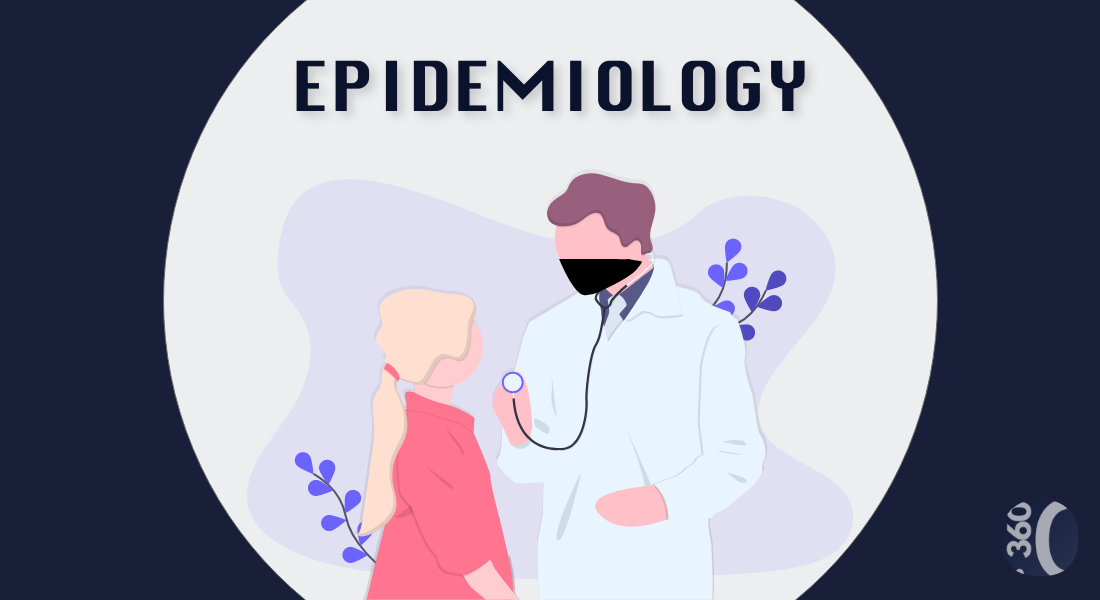Epidemiological information or research is planned in such a way so that it can evaluate strategies to prevent illness from spreading and also helps to manage a patient who is already infected by the disease and has developed symptoms of the same

Meaning: Epidemiology is the branch of medical science that explores all the factors which determines the presence and absence of diseases and disorders. It can also be defined as the study of how often diseases tend to occur in different types of people or community. Epidemiological information or research is planned in such a way so that it can evaluate strategies to prevent illness from spreading and also helps to manage a patient who is already infected by the disease and has developed symptoms of the same. It also helps us to comprehend how many people are infected by a disease or have a disorder, if there is any change in the numbers, and how the disorder affects our society and our economy as well. The epidemiology of a disease is an integral part of its basic description like clinical findings and pathology for example. However, the epidemiology of human transmission is a challenging field as many epidemiological estimates try to determine how many people affected by a disorder changes over a certain time- period. Furthermore, steady but constant change in the definition of a disorder also tends to change over time thus making the estimates more complex. Even scientists have difficulties in ascertaining the best way to measure or define a specific disorder. Initially, epidemiology was only used to study diseases such as cholera. However, now epidemiology is applied to all kinds of health-associated conditions such as diseases (e.g. influenza, cancer, and depression), health problems (e.g. obesity, high blood pressure), injuries (e.g. work-related, traffic-related) and social problems (e.g. gambling, domestic violence).
A differentiating feature of epidemiology is that it studies health-associated situations at the population level, as opposed to the individual level. The best way to apprehend this is to compare the differing approaches of clinicians and epidemiologists to these diseases.
Doctors and other clinicians are mainly concerned with the effects of disease within an individual. They work on individual patients to diagnose problems and ascertain what steps can be taken to make them healthier.
Epidemiologists, on the other hand, are more concerned with how diseases affect society as a whole. They conduct studies on the population at large in order to diagnose and respond to illnesses in populations: how many people are affected (i.e. prevalence), who is affected and why (i.e. determinants of health), and determine do’s and don’ts to cure or prevent these illnesses at a community level (e.g. treatment protocols, public health interventions).
Key terms in the field of epidemiology:
- Incidence: Number of new cases of a disorder or a disease emerging or showing symptoms in the population over a certain period.
- Prevalence: Number of existing cases of a disease in a population at a given point of time.
- Cost of illness: Several reports use expenditures on medical care as the cost of illness. The cost of illness would also take into account certain factors that are more complex to measure, such as work concomitant expenditure, educational expenditure, the cost of support services required by the medical condition, and the amount that the individual would be able to pay to avoid health risks.
- The burden of disease: The total prominence of disease for society, beyond the immediate cost of treatment. It is ascertained in a ratio of years of life lost to ill health, or the difference between total life expectancy and disability-adjusted life expectancy.
- Disability-Adjusted Life Year (DALY): An epitomized measure of the health of a population. One DALY is equivalent to one lost year of healthy life and is used to ascertain the lacuna between the current average health of a population and an ideal situation in which everyone in that population would live into old age healthy. Adapted from the World Health Organisation (WHO).
- Case definition: In the field of epidemiology, a set of criteria is used in decision making as to whether an individual has a disease or health event of interest. Ascertaining a case definition is an obligatory step in quantifying the magnitude of disease in a population. Case definitions are utilised in on-going public health surveillance to track the occurrence and dissemination of disease within a given area, as well as at the time of investigation of an outbreak in the field of epidemiology. Case definition must be unambiguous, simple, and concise, allowing it to be applied to all the individuals in the population of interest which includes both clinical and laboratory attributes, which can be determined with the help of a different set of techniques including diagnosis by a physician, completion of a survey, or routine population screening techniques.
Many National and International Organizations taking initiative have made public lists of uniform case definitions for the compulsory reporting of a specific disease. Publication of these lists is very useful as it includes emphatic case definitions, providing the opportunities to the clinicians to report cases for diseases of interest to public health authorities in a universal and standard form across geographical locations around the globe. This is significantly important and useful for studies to compare the pervasiveness of a particular disease across different regions since they can also use the same case definitions and obtain a relatively accurate evaluation of the disease. At the time of an on-going outbreak of disease, a case definition is developed in the nascent stage of an investigation of an outbreak, promoting the identification of individual cases. Also, the same criteria apply for ascertaining a case definition by way of routine public health surveillance at the time of an on-going outbreak, investigation of a case definition must also include important information about the individual, time and place, in addition to clinical and laboratory characteristics. Case definition at the time of an outbreak of foodborne illness may only include certain individuals who ate at a particular restaurant at a specified time period. Also, a case definition must be vividly explained during the nascent stages of an on-going outbreak investigation scenario to encourage sensitivity and allowing the recording of as many cases as possible while also minimizing the possibility of ignoring the cases. As the investigation continues and more knowledge is obtained about the nature of the cases, the definition may be narrowed down, making it more specific. This is particularly important for a rare emerging disease where a standard case definition does not yet exist like the on-going COVID-19 outbreak.
- Initiatives taken by the World Health Organisation (WHO) towards epidemiology are:
- Global Epidemiological Surveillance Standards for Influenza: This document contains WHO global standards for influenza surveillance. This was initiated by the World Health Organisation (WHO) following a global consultation on influenza surveillance standards held in Geneva in March 2011.
- Weekly Epidemiological Monitor: The weekly Epidemiological Monitor is a regional office publication produced by the pandemic and endemic-prone disease programme. Aimed at sharing information and forge sustainable technical collaboration between the member states and the technical programmes under the Regional office. It is vastly circulated amongst the leaders in public health to strengthen partnerships and promote better health. The main motive behind this communication is to provide credible, timely and concise information about the public health events that might constitute public health exigencies of regional and or international concern. This publication not only helps in keeping a record of significant public health programs happening in specific regions via sharing information but also promotes transparency and preparedness of the Member States for public health events of international importance.
- The Weekly Epidemiological Record (WER): The Weekly Epidemiological Record (WER) is an important instrument keeping in mind the rapid and precise dissemination of epidemiological information on certain cases and the outbreak of diseases under the International Health Regulations and on any communicable diseases that are of utmost public health importance, including emerging or re-emerging infections.
Importance of epidemiology can be ascertained during the outbreak of diseases whether it be plague, syphilis, smallpox in history or the current outbreak of the COVID-19. However, there is lack of information amongst people towards this particular field and less participation in these types of sciences by the people which is very unfortunate. With the outbreak of the pandemic such as COVID-19, it becomes imperative that a concerted effort must take place to spread awareness amongst people across the globe to develop an effective mechanism along with proper infrastructure to tackle the outbreak of the contagious diseases.




